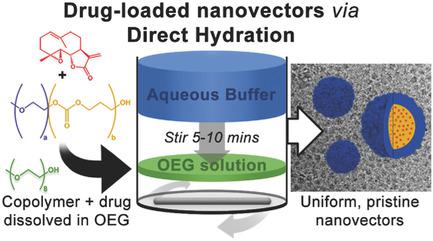Our official English website, www.x-mol.net, welcomes your feedback! (Note: you will need to create a separate account there.)
Biodegradable, Drug‐Loaded Nanovectors via Direct Hydration as a New Platform for Cancer Therapeutics
Small ( IF 13.3 ) Pub Date : 2018-07-12 , DOI: 10.1002/smll.201703774 Roxane Ridolfo 1 , Benjamin C. Ede 2 , Paraskevi Diamanti 2, 3 , Paul B. White 4 , Adam W. Perriman 2 , Jan C. M. van Hest 1 , Allison Blair 2, 3 , David S. Williams 1, 5
Small ( IF 13.3 ) Pub Date : 2018-07-12 , DOI: 10.1002/smll.201703774 Roxane Ridolfo 1 , Benjamin C. Ede 2 , Paraskevi Diamanti 2, 3 , Paul B. White 4 , Adam W. Perriman 2 , Jan C. M. van Hest 1 , Allison Blair 2, 3 , David S. Williams 1, 5
Affiliation

|
The stabilization and transport of low‐solubility drugs, by encapsulation in nanoscopic delivery vectors (nanovectors), is a key paradigm in nanomedicine. However, the problems of carrier toxicity, specificity, and producibility create a bottleneck in the development of new nanomedical technologies. Copolymeric nanoparticles are an excellent platform for nanovector engineering due to their structural versatility; however, conventional fabrication processes rely upon harmful chemicals that necessitate purification. In engineering a more robust (copolymeric) nanovector platform, it is necessary to reconsider the entire process from copolymer synthesis through self‐assembly and functionalization. To this end, a process is developed whereby biodegradable copolymers of poly(ethylene glycol)‐block‐poly(trimethylene carbonate), synthesized via organocatalyzed ring‐opening polymerization, undergo assembly into highly uniform, drug‐loaded micelles without the use of harmful solvents or the need for purification. The direct hydration methodology, employing oligo(ethylene glycol) as a nontoxic dispersant, facilitates rapid preparation of pristine, drug‐loaded nanovectors that require no further processing. This method is robust, fast, and scalable. Utilizing parthenolide, an exciting candidate for treatment of acute lymphoblastic leukemia (ALL), discrete nanovectors are generated that show strikingly low carrier toxicity and high levels of specific therapeutic efficacy against primary ALL cells (as compared to normal hematopoietic cells).
中文翻译:

通过直接水合作用可生物降解的载药纳米载体,作为癌症治疗的新平台
通过封装在纳米级递送载体(纳米载体)中,低溶解度药物的稳定和运输是纳米医学的关键范例。然而,载体毒性,特异性和可生产性的问题在新的纳米医学技术的发展中造成了瓶颈。共聚物纳米粒子具有结构通用性,因此是用于纳米载体工程的出色平台。然而,常规的制造过程依赖于需要纯化的有害化学物质。在设计一个更强大的(共聚)纳米载体平台时,有必要重新考虑从共聚物合成到自组装和功能化的整个过程。为此,开发了一种方法,通过该方法可生物降解聚(乙二醇)嵌段共聚物通过有机催化的开环聚合反应合成的聚碳酸三亚甲基酯可以组装成高度均一的,载有药物的胶束,而无需使用有害溶剂或无需纯化。直接水合方法采用低聚乙二醇作为无毒分散剂,有助于快速制备不需要药物进一步加工的原始药物载纳米载体。该方法是健壮,快速和可扩展的。利用单性酚,一种治疗急性淋巴细胞白血病(ALL)的令人兴奋的候选药物,可产生离散的纳米载体,这些载体表现出极低的载体毒性和对原代ALL细胞的高特异性治疗功效(与正常造血细胞相比)。
更新日期:2018-07-12
中文翻译:

通过直接水合作用可生物降解的载药纳米载体,作为癌症治疗的新平台
通过封装在纳米级递送载体(纳米载体)中,低溶解度药物的稳定和运输是纳米医学的关键范例。然而,载体毒性,特异性和可生产性的问题在新的纳米医学技术的发展中造成了瓶颈。共聚物纳米粒子具有结构通用性,因此是用于纳米载体工程的出色平台。然而,常规的制造过程依赖于需要纯化的有害化学物质。在设计一个更强大的(共聚)纳米载体平台时,有必要重新考虑从共聚物合成到自组装和功能化的整个过程。为此,开发了一种方法,通过该方法可生物降解聚(乙二醇)嵌段共聚物通过有机催化的开环聚合反应合成的聚碳酸三亚甲基酯可以组装成高度均一的,载有药物的胶束,而无需使用有害溶剂或无需纯化。直接水合方法采用低聚乙二醇作为无毒分散剂,有助于快速制备不需要药物进一步加工的原始药物载纳米载体。该方法是健壮,快速和可扩展的。利用单性酚,一种治疗急性淋巴细胞白血病(ALL)的令人兴奋的候选药物,可产生离散的纳米载体,这些载体表现出极低的载体毒性和对原代ALL细胞的高特异性治疗功效(与正常造血细胞相比)。

























 京公网安备 11010802027423号
京公网安备 11010802027423号